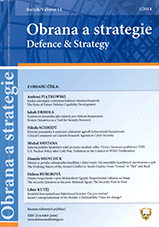Jaderná politika Spojených států po konci studené války Vývoj v kontextu proliferace ZHN
U.S. Nuclear Policy after Cold War Evolution in the Context of WMD Proliferation
Author(s): Michal SmetanaSubject(s): Politics / Political Sciences
Published by: Univerzita obrany
Keywords: United States; nuclear policy; WMD proliferation; nuclear weapons; military doctrine
Summary/Abstract: WMD proliferation is often considered to be one of the gravest security threats of our time. This article aims to explore how the post-Cold War securitization of this phenomenon influenced the evolution of U.S. nuclear policy. The systemic change related to the collapse of bipolar world order is depicted as a major impulse which led to the need to redefine the role of American nuclear weapons. The conceptual shift from global to regional approach in U.S. foreign and defense policy as well as particular experience of the Gulf War brought about the emergence and subsequent institutionalization of a number of counterproliferation programs and initiatives, effectively serving as a new rationale for U.S. nuclear arsenal. In the context of U.S. nuclear policy of the first post-Cold War decade, the author identifies an inception of a number of still highly relevant strategic trends. These include qualitative improvements of nuclear weapons towards their greater practical usability in the new security environment, limited ballistic missile defense as a key strategic defensive element against WMD attack, emphasis on flexible nuclear planning or the formulation declaratory policy for nuclear use. A detailed exploration ofthe particular circumstances in which these trends appeared and have become an integral part of U.S. strategic posture is therefore a crucial prerequisite for deeper understanding of contemporary U.S. nuclear policy.
Journal: Obrana a strategie
- Issue Year: 14/2014
- Issue No: 1
- Page Range: 39-50
- Page Count: 12
- Language: Czech

